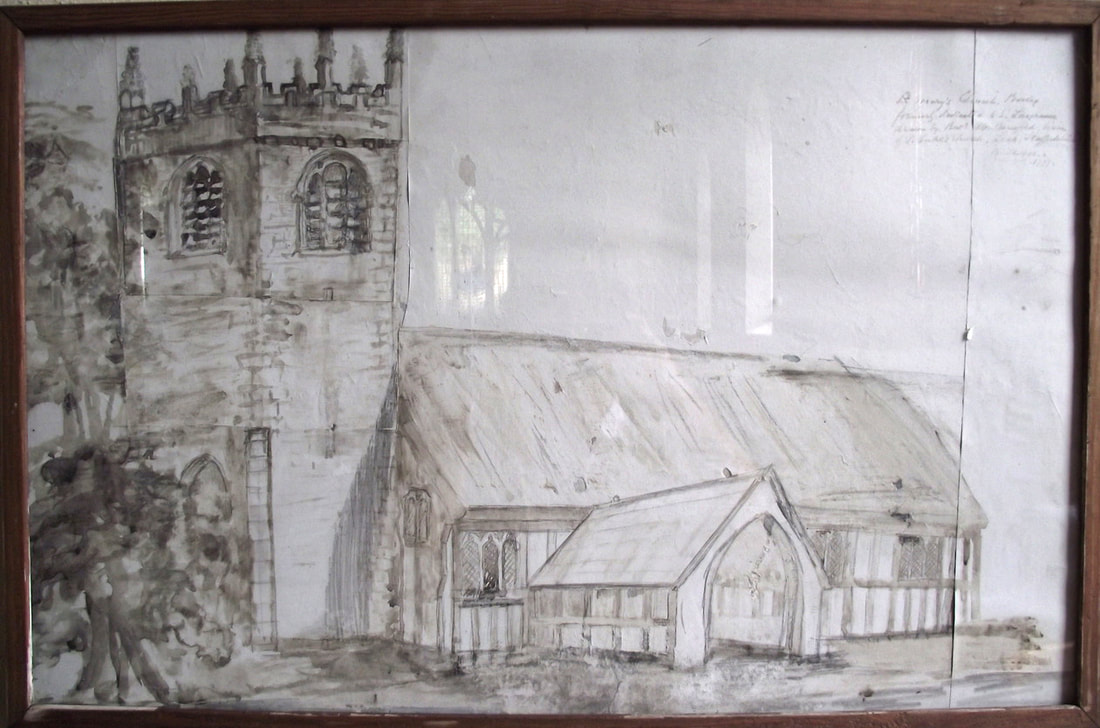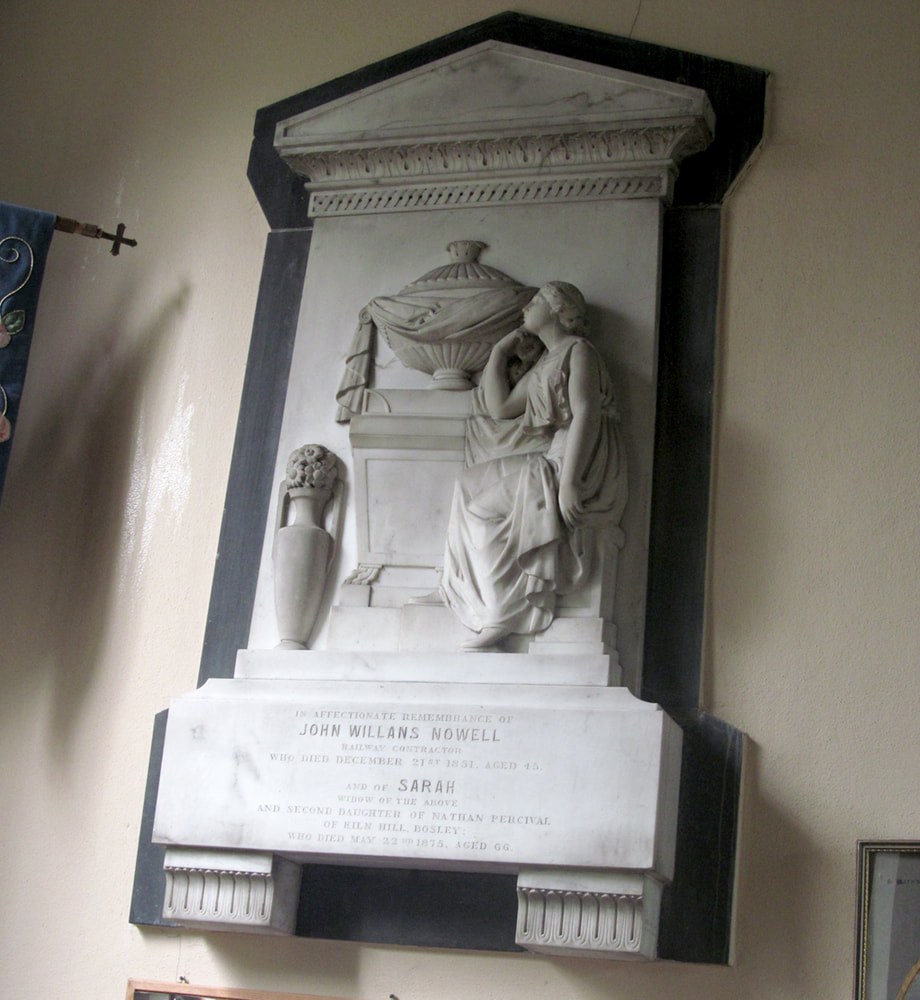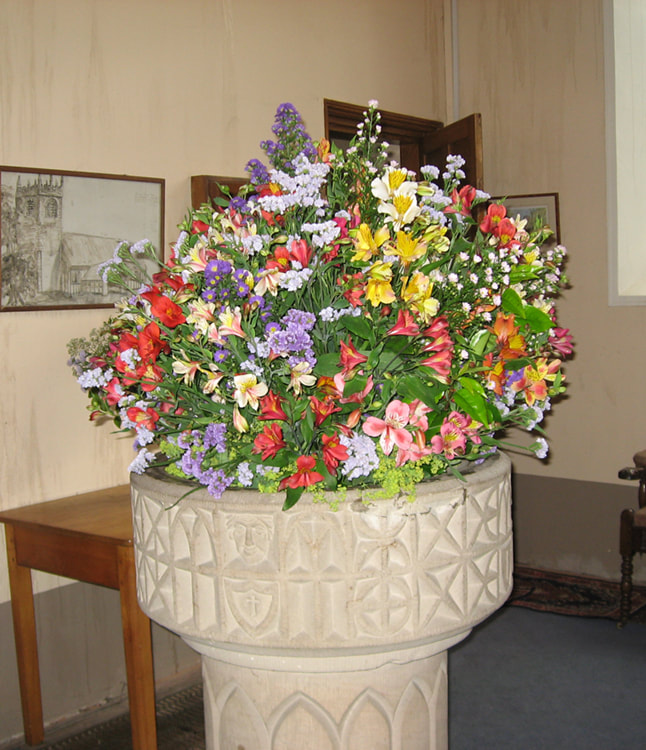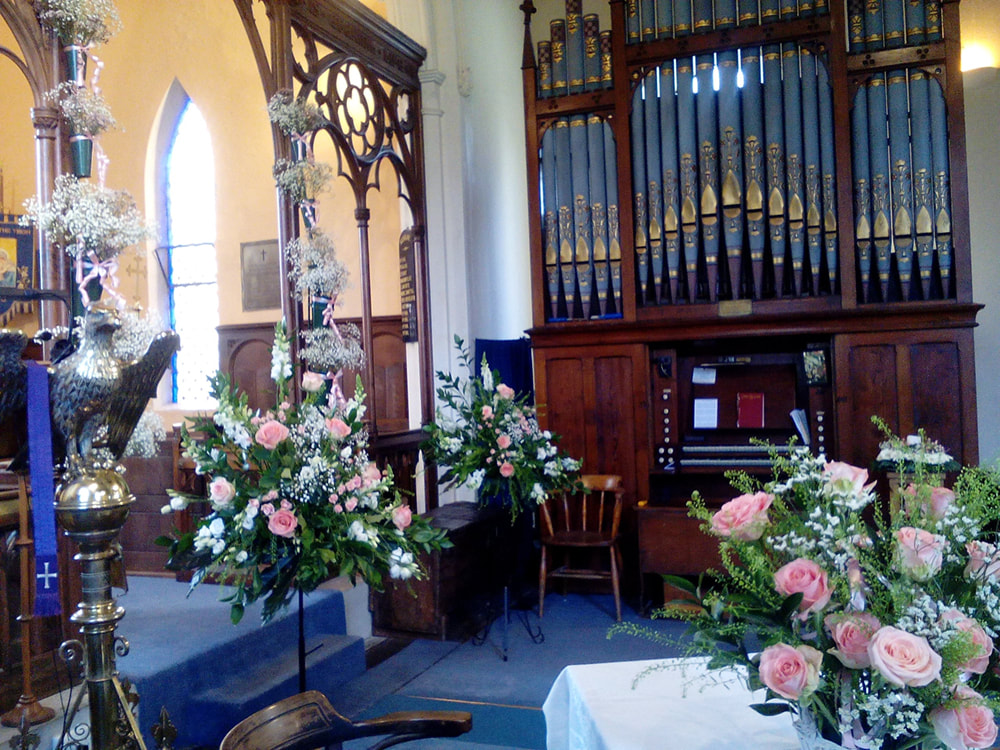History of Bosley Church
|
The church is recorded in the National Heritage List for England as a designated Grade II* listed building. The church was originally dedicated to St. Thomas a Becket of Canterbury but later this was changed to St. Lawrence and then to St. Mary the Virgin. It was formerly a chapel of ease for Prestbury, and was granted the right to have a font and burial ground by Pope Boniface in a Papal Bull of 5 April 1402 as recorded at Lichfield. The parish registers go back to 1728 and the list of vicars to approximately 1596.
The original church, built in 1402 on the authority of a Bull issued by Pope Boniface IX while Henry IV was King of England, was a Chapel of Ease to the Parish Church of Prestbury. The Tower, built of local sandstone, the nave and chancel were timber and plaster and the roof thatched. It is now dedicated to St. Mary the Virgin and was originally dedicated to St. Thomas the Martyr and later to St. Lawrence. The sketch of this building on the west wall shows the main entrance on the south side. It was burnt down in 1770 leaving only the tower, rebuilt in brick in 1777 and enlarged by the addition of a chancel which added 110 extra sittings in 1834 when William Sutcliffe was the minister. There is a plaque on the south wall to this end. The young Berisford mentioned in the records of Bosley by Rev Wm Sutcliffe would certainly have been the same Beresford who had drawn the picture. He would have been 21 at that time. William was well known for his writings on many subjects as well as his in depth research into the Beresford family. William's parents were Samuel and Harriet Beresford. Samuel was shown as parish clerk and schoolmaster at the time of Williams baptism at Bosley in 1844. The family moved to Meerbrook between the 1851 the 1861 census. William was shown as a pupil teacher on the 1861 census. I believe he was Curate of St Alkmund’s Derby 1867-75 and vicar of St Chad’s Stafford until 1882 before becoming vicar of St Lukes Leek from 1882-1919 he was Rural Dean between 1904-16. The late vicar of St Luke's Leek was laid to rest in Meerbrook church yard on Monday 8th October on the north side of the church from which there is a beautiful view of the Roaches Mr Bereford's birth place has become his last earthly resting place where also his wife is laid. His ministry was entirely in the County of Stafford until his retirement from St Luke's Leek 1919. The church of England school in the Noir Lane district of Leek is a memorial to him and is officially known as Beresford Memorial School, |
A list of ministers on the east wall by the entrance goes back to 1596. John Thorley, minister from 1728-65 lived in the church tower which was the customary residence of the minister. The old school was built in 1736 in what is now the churchyard. Edward Dawson gave £12 towards the building and £12, the interest of which was to be paid to the poor for ever. (see the plaque on the south wall).
When William Sutcliffe became minister in 1833, the building was no longer there and ‘The Old School Cottages’ were built to house the school and caretaker. The vicarage was built on land to the south of the church in 1853 and by 1858 a new school, big enough to take more pupils was built in land across the road. The Old Cottages were demolished in 1937.
When William Sutcliffe became minister in 1833, the building was no longer there and ‘The Old School Cottages’ were built to house the school and caretaker. The vicarage was built on land to the south of the church in 1853 and by 1858 a new school, big enough to take more pupils was built in land across the road. The Old Cottages were demolished in 1937.
|
The railway and viaduct costing £100,000 over the Dane were constructed at this time and William Sutcliffe undertook the chaplaincy when about 2,000 navies were employed. There is a wall monument in church to John William Nowell, who died in 1851, a railway contractor and was probably involved in the construction. He was married to local girl, Sarah Percival, of Kiln Hill. Their son has a plaque on the north wall.
|
George Edwin O’Brien, minister from 1891-1916, carved the front of the altar table and the two high backed armchairs in the chancel. There are words carved on the south side of the choir stalls. After the fire The ancient font was used as a pig trough in a local farm, was rescued and replaced on a new pedestal in 1848 and the face and three escutcheons bearing EEIS added by the mason.
|
|
|
|
Behind every headstone in a grave yard are many stories, most are forgotten and beyond recall. There is a headstone in Bosley Church yard, it is near to the path as you walk from the Church to the gate. " Asleep in Jesus M H Brassington Wesleyan Minister Queensland died 10th March 1894 in his 26th year". I have often wondered what his story was? None of the local Methodist families, who go back several generations seemed to know anything about him. I presumed he was a bachelor with a local connection who had died in his prime.
A few weeks ago we had a surprise email from his great grandson Mark who was researching his ancestors. M H Brassington certainly had a story! This is an abridged version of the story that Mark has sent. Harry Brassington was the youngest of John and Betty Brassington's 11 children. They lived at No 40 Bosley Works. John worked for Frank Thompstone, when the "The Works" was a corn mill. The family were committed Wesleyan Methodists and regulars worshipers at the Chapel at Bosley Works. [The Chapel pre 1885 was across the road from the Dane, below the main mill] In the 1870s John Brassington took on the mill at Rushton, so was now a miller on his own account. Harry found his mission at Rushton chapel where Thomas, his elder brother and young Harry became enthusiastic preachers. In 1882 Thomas emigrated to Australia to become a minister and help spread the word in the new colony. In the late 1880s Harry, aged just 20 decided to follow his brother to Australia, a decision that cannot have been taken lightly. It shows his deeply held faith and his determination to become a minister even if this takes him to the opposite end of the world. When Harry arrived in Australia, Thomas, now aged 32, has been a Minister at Gympie, a miming "Gold rush town" in Queensland for six years, he had a reputation in the church as a passionate, evangelical preacher. Harry followed him to Gympie! History books tell us a gold rush town, was not a place for the faint hearted to preach the Gospel of Jesus! For a young man of 20 from Rushton to be posted to a rough gold mining town was a challenge! Queensland Methodists were yet to set up formal training for ministers, so Harry was thrown in at the deep end with little knowledge of his role, his congregation or the environment. But he must have risen to the task for the "Gympie Times" in the summer of 1891 records -- The Rev. M. H. Brassington delivered his farewell sermons on Sunday, in the morning at the Wesleyan Church "Surface Hill" and at the "Two-Mile" in the evening, the churches being well filled on both occasions. Mr. Brassington leaves Gympie on Saturday for his new sphere of labour, Charters Towers. Charters Towers is another gold rush town, further north in Queensland where the colonialists were fewer and the temperatures are higher. It is here that the new Methodist Minister, no doubt nervous, meets the intimidating head teacher of the Girls School, Martha Hustwick. But an unlikely close relationship forms. Martha came to Australia with her consumptive sister Emily, hoping that the climate might cure her TB, but unfortunately Emily died and instead of returning to Durham, Martha finds work as a teacher and quickly rises to become Headteacher. Martha couldn't have failed to notice that Harry is also showing the dread symptoms of TB. The Methodist newspaper reported: The Rev. M. H. Brassington, of Charters' Towers, is seriously ill with an affection of the lungs. Yet in May 1893 Martha marries Harry. That they decide to marry is an extraordinary decision. Harry is ten years younger, no money, and suffering from TB. Martha will be well aware of the likely outcome of Harry’s illness, that her marriage will be short and that she will be left a widow. She also knows the education department specifically forbids married women from teaching, so marrying Harry will also end her career. But they marry anyway, their feelings for each other must run deep. Just two months after their wedding, in July 1893 Harry and Mattie board ship to come back home. Martha writes to her sister from on board the ship, telling her that she is pregnant, and of her hopes that a cure for TB might be found in England, and how glad she would be to get to London so that a Dr’s advice could be obtained. However, any hopes of a cure are dashed and the couple make their way to Rushton. In the four years while Harry has been away his father John has died, so Harry and Martha go to Fir Tree Farm, Rushton. Harry’s sister Elizabeth lives there with her husband John Bailey and a young family. Martha writes to her sister again: This fine country air and farmhouse life are doing him good. We have been here just a week & he seems a good deal better and says he feels stronger. I am enjoying the change too, you cannot imagine the positive pleasure it is to look out on a beautiful English landscape, & to walk in fields and lanes. I went to Chapel on Sunday afternoon & the walk there and back did me more good than any sermon I ever heard. However, a few weeks later Martha writes: Harry keeps much about the same, keeping his bed until afternoon & then getting up for a few hours’ change. Yesterday he was very bad all day with nervousness & exhaustion. . . He likes the blouse you made me, thinks it suits me & then says that “a good looking woman looks well in anything” — gross flattery is it not! In February 1894 Harry’s daughter Hilda May is born. The celebrations that baby and mother survive the rigours of childbirth will be tempered by the fact that Harry must be very ill by now. Martha will be torn between nursing her baby daughter and nursing her dying husband. The inevitable conclusion to Harry’s long illness finally arrives on 10 March 1894 at Fir Tree Farm, Rushton. Less than a year after he married Martha and a month after his daughter Hilda is born, Harry dies aged just 25. Martha buries him in Bosley churchyard in the village where he was born and she returns to Durham where her family still live. Harry has managed to pack a great amount of work into his brief life. He became a Methodist preacher in his teens, travelled across the world to an unknown continent, became a Methodist Minister in a "Gold Rush" town to spread the "Good news of the Gospel" in the John Wesley spirit. As a young, idealistic, earnest minister he worked to bring a moral and spiritual life to mining communities in Australia, surely one of the toughest audiences in the world. Mark | |||||||




